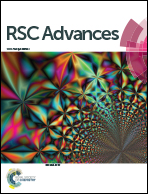Enhancing the performance of blue quantum-dot light-emitting diodes through the incorporation of polyethylene glycol to passivate ZnO as an electron transport layer†
Abstract
The balance between charge transport and charge injection is always a key factor in enhancing the performance of quantum-dot light-emitting diodes (QD-LEDs), particularly for the blue QDs due to their large optical band gap and relatively low valence band level compared with their green and red counterparts. High performance blue QD-LEDs have been demonstrated by blending polyethylene glycol (PEG) into solution-processed ZnO nanocrystals as the electron transport layer. PEG can effectively tune the electron mobility of ZnO and simultaneously passivate its surface defect states. As a result, the maximum current efficiency (CE) and external quantum efficiency (EQE) of the blue QD-LEDs increased from 4.33 cd A−1 and 9.98% for pure ZnO to 8.03 cd A−1 and 14.84% for 4% PEG blended into ZnO, respectively. Furthermore, operational lifetime of the device is also significantly improved from 8.95 h to 25.06 h. This result indicates that PEG is a promising material for regulating the charge balance of the blue QD-LEDs.



 Please wait while we load your content...
Please wait while we load your content...